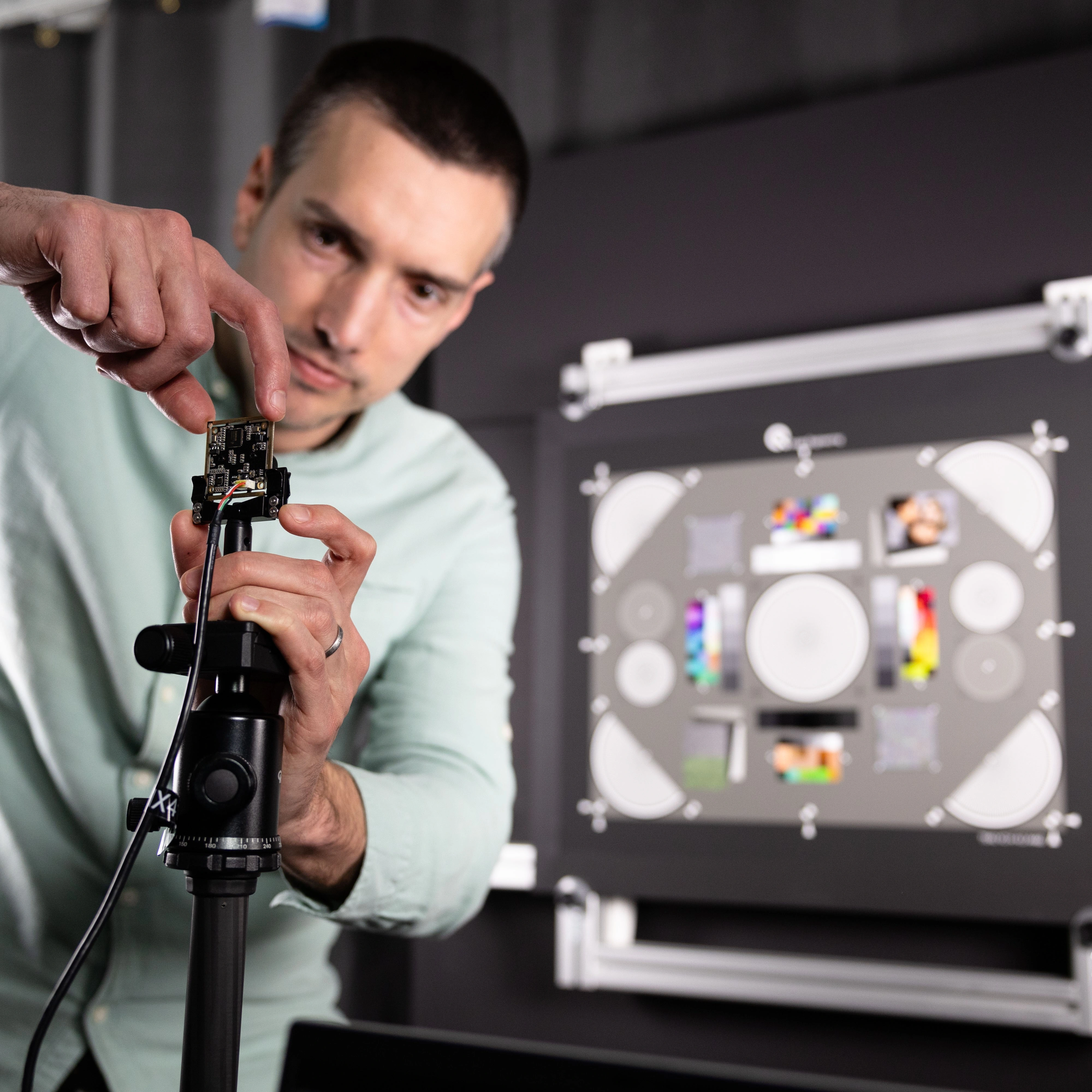Premium smartphone cameras such as those in iPhones have largely replaced traditional cameras. Thanks to increasingly better hardware, intelligent algorithms, and artificial intelligence (AI), the image quality has now reached an outstanding level. But can the image quality of a low-cost camera be pushed to approach the level of an iPhone 15 Pro? The specialists at Helbling are repeatedly confronted with this question and so have conducted extensive tests and experiments. The results are already being implemented in current Helbling projects for customers.
Initial situation: Expectations grow with progress
The technical progress in smartphone photography is undeniable. Our phones are always with us, and image quality is at its peak. At tourist attractions worldwide, compact cameras are almost nowhere to be seen; professional system cameras are becoming rarer, while smartphone cameras dominate the scene. As a result, users’ expectations for inexpensive cameras have also risen. At the same time, Helbling has noticed a trend among customers expecting outstanding image quality from camera modules while also assuming that the costs for the camera module (comprising the sensor, lens, and housing) should remain in the low-dollar range.
This demand became particularly evident in a recent project by Helbling: a customer requested image quality comparable to that of an iPhone for their low-cost camera module.
To meet this demand, Helbling systematically evaluated various consumer and industry cameras in the laboratory and analyzed the potential of small, low-cost camera modules. Finally, a test was conducted to determine the extent to which the image quality of a low-cost camera can be improved to approach the level of an iPhone 15 Pro.
Camera test stand: Which measurements are most relevant?
Even though image quality is often subjective and depends on personal preferences, many parameters can be measured according to standards such as ISO 12233, ISO 15739, or ISO 17321. These standards can be systematically measured using a test setup (see Fig. 1). In this case, the camera test setup consisted of a multipurpose test chart, a dimmable lighting unit with adjustable color temperature, and a centrally mounted tripod in front of the test chart.

The TE42 test chart from Image Engineering was used for Helbling's camera test setup. This test chart allows the measurement of diverse camera quality characteristics within a single image. However, this article focuses only on the three aspects of resolution (or modulation transfer), dynamic range, and color reproduction.
Various features of the test chart (see Fig. 2) are used for evaluation. The Siemens star, positioned centrally and in the corners of the test chart, consists of alternating black and white segments. Due to the lens’ limited optical resolution, the increasingly delicate structures toward the center can no longer be accurately reproduced beyond a certain point. This characteristic, often colloquially referred to as image sharpness, describes modulation transfer. The MTF50 value is commonly used to assess modulation transfer, indicating the spatial frequency at which contrast drops to 50% of maximum modulation. The MTF50 value can be expressed in line pairs per picture height (lp/ph).
Additional test chart elements include gray fields to determine the dynamic range, which is defined as the ratio between the maximum and minimum detectable intensity. The color patches are used to evaluate color reproduction, with deviations from the defined test chart color values quantified using the Euclidean color distance: a higher value indicates a greater color deviation than a lower value (see Fig. 2).
Analysis of the captured images was conducted using Image Engineering’s iQ-Analyzer-X software.
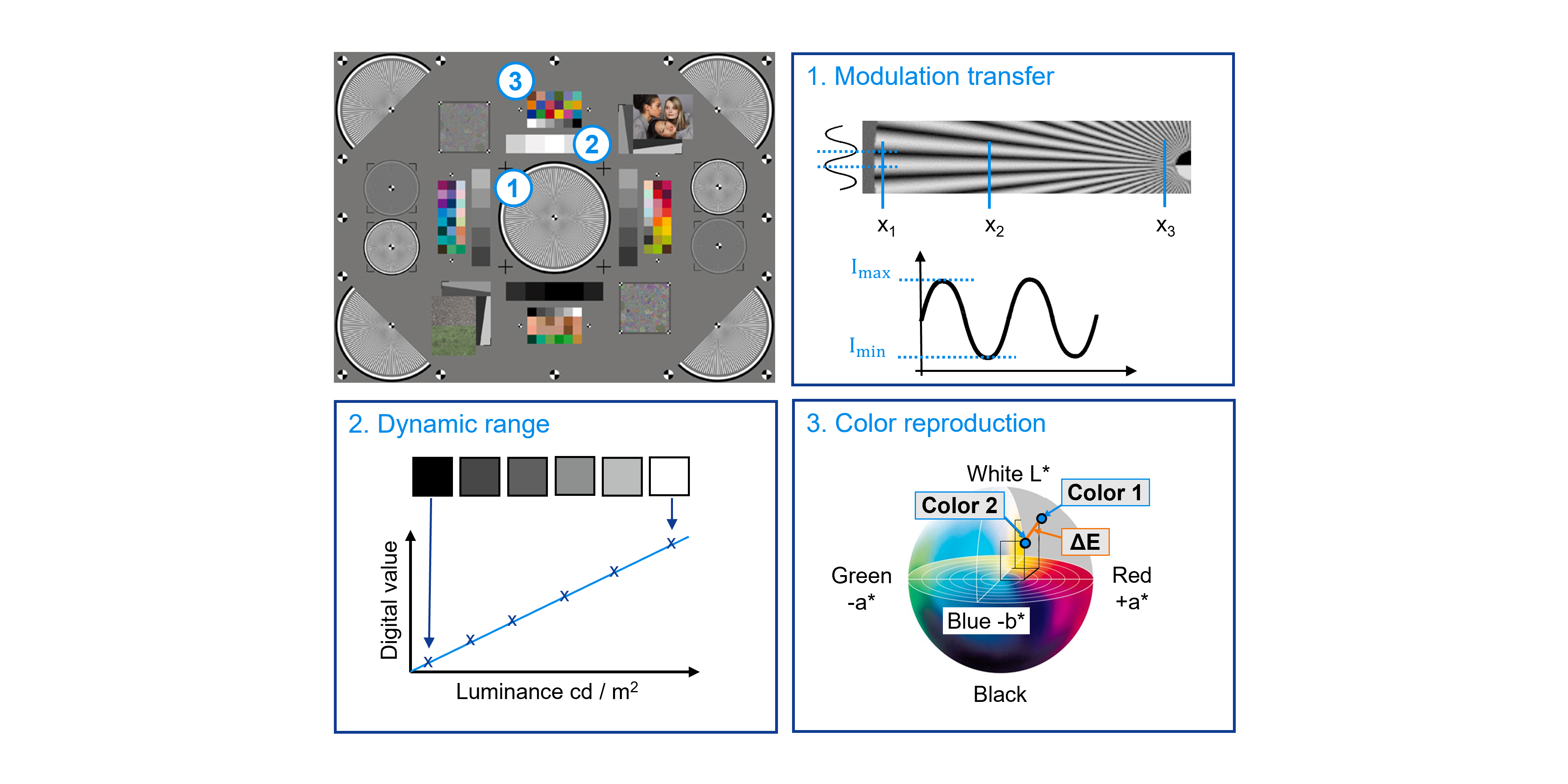
Comparison: iPhone 15 Pro vs. low-cost camera
The test setup was used to compare the image quality of a low-cost camera module with that of an iPhone 15 Pro, as shown in Figure 3. While the iPhone 15 Pro was available for around 1,000 CHF at the time of testing, the price for the Raspberry Pi V2 camera with a MIPI interface and a Sony IMX219 image sensor was 8.95 CHF. In specialized Chinese online shops, the same camera module could even be purchased for just under 4.50 CHF at that time. The Raspberry Pi V2 camera was connected to an AM62A7 processor using a MIPI interface.
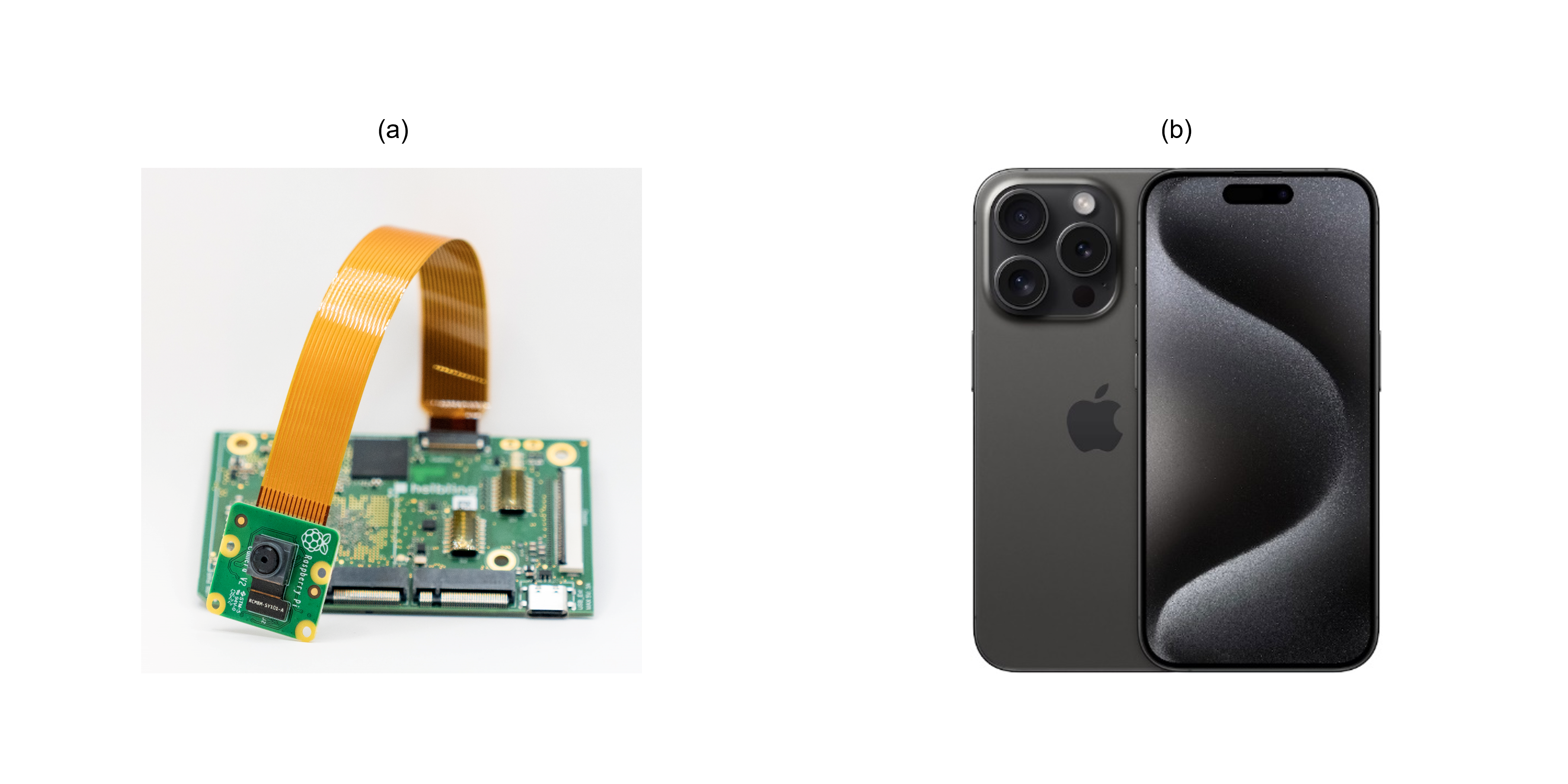
Measurement of the modulation transfer function (see Fig. 4) clearly shows that the iPhone offers better resolution and slightly superior imaging performance versus the low-cost Raspberry camera. However, the difference may appear surprising at first glance: While the MTF50 value for the iPhone at its full resolution of 24 MP (megapixels) is 1,350 lp/ph in the center of the image and 1,180 lp/ph in the corners, it drops to 770 lp/ph in the center and 740 lp/ph in the corners at the standard resolution of 12 MP. In contrast, the MTF50 value for the 8 MP Raspberry camera is 860 lp/ph in the center and 730 lp/ph in the corners. The impact of image processing algorithms is particularly interesting: the 24 MP images of the iPhone are sharpened through software processing. This is evident from the overshoot of the measurement curve at around 450 lp/ph. However, this effect is not as clearly visible on the iPhone at the standard 12 MP resolution.
The same effect is even more conspicuous with the Raspberry camera: for this, Helbling’s specialists deliberately applied an "edge enhancement" filter to improve image sharpness. This filter meant that the low-cost camera could surpass the iPhone's 12 MP MTF50 value in the center despite its lower resolution of 8 MP. However, the iPhone maintained consistent imaging performance across the entire image, whereas the Raspberry Pi V2 camera showed a noticeable drop in performance toward the edges.
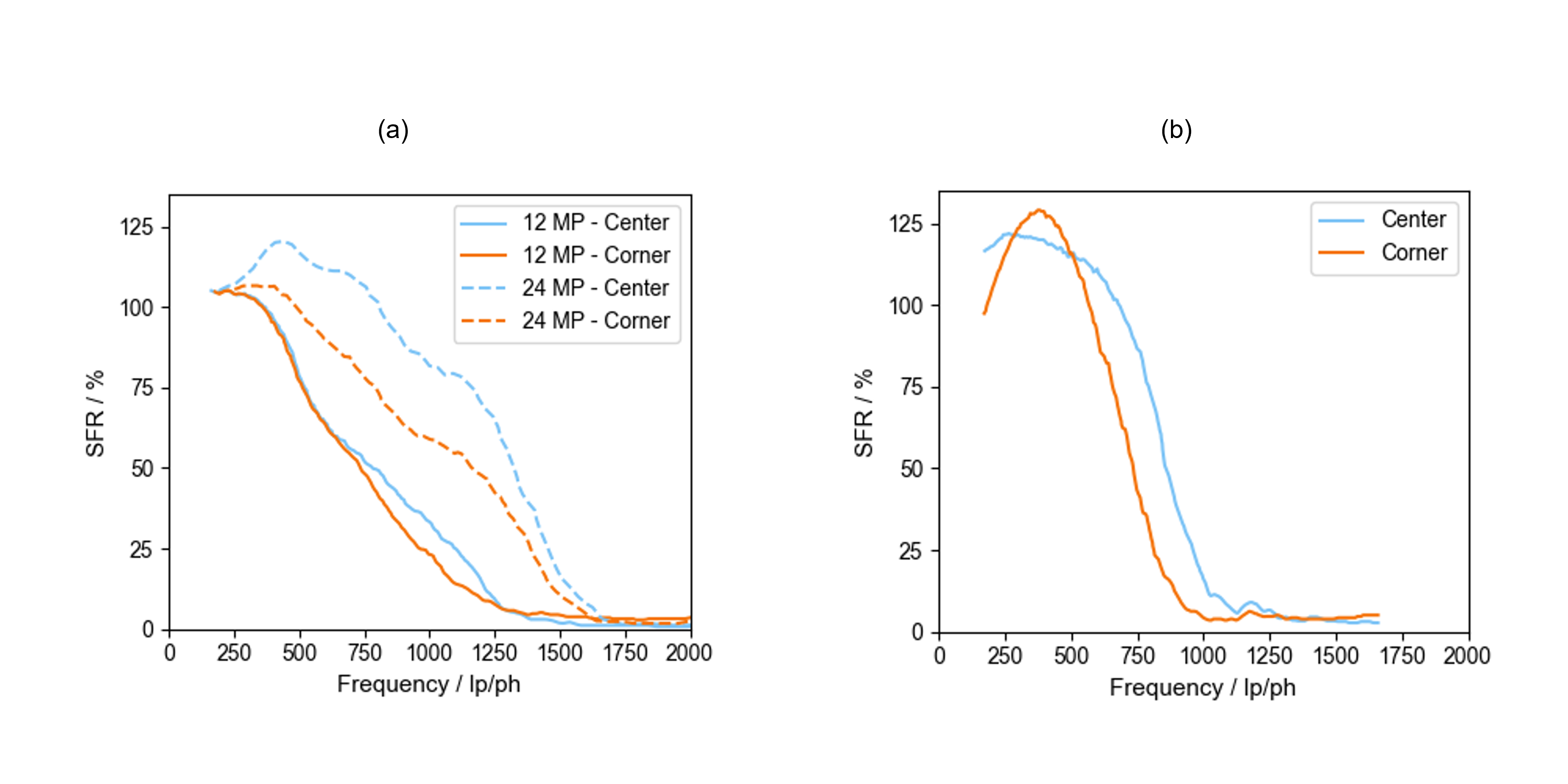
While the dynamic range of both cameras is surprisingly similar, a look at their color reproduction (see Fig. 5) reveals a striking difference: the color accuracy of the Raspberry camera is significantly closer to the target than that of the iPhone. In general, the Euclidean color distances of the low-cost Raspberry camera module are smaller than those of the iPhone.
In particular, red and green tones show a greater color deviation on the iPhone 15 Pro. This phenomenon can also be observed in other smartphone cameras; in fact, the effect was even more pronounced in Samsung smartphones measured by Helbling. The suspicion is that camera manufacturers deliberately enhance color tones to make images appear more vibrant. As a result, grass looks greener, the sky bluer, and sunsets more dramatic.
However, both cameras exhibit very good color accuracy for grayscale values ranging from white to black.
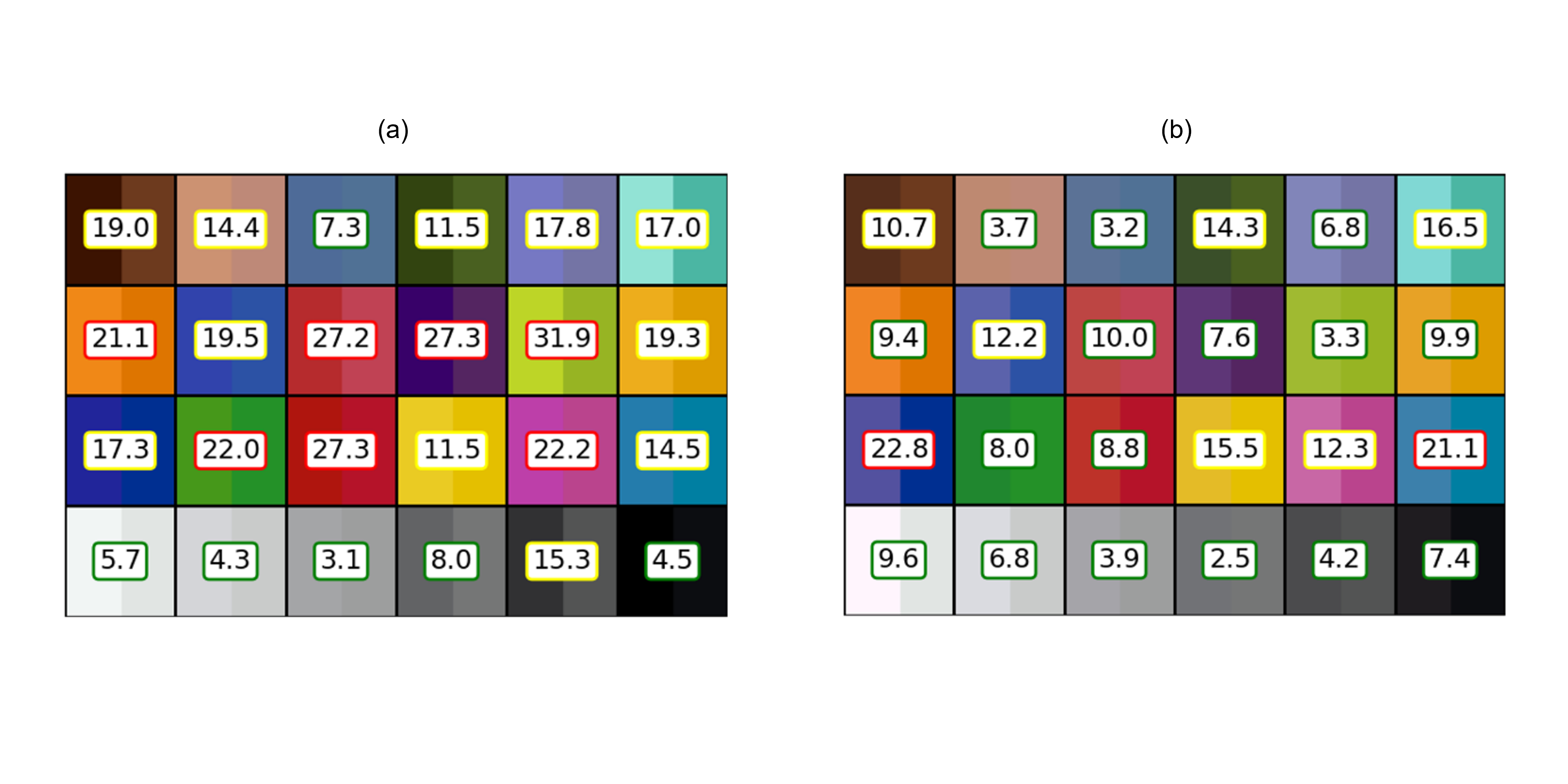
Tuning: How transferable is the iPhone’s color reproduction?
Since Apple and Samsung enhance colors for a more vibrant look, to what extent can the color reproduction of the Raspberry Pi V2 camera be adjusted to match that of an iPhone? Specifically, could red, green, and blue tones be adapted to create images similar to those of a smartphone?
Regarding the Helbling setup used for testing the Raspberry Pi V2 camera: the Raspberry Pi V2 is a low-cost camera featuring a Sony IMX219 image sensor. It was connected via a MIPI interface to a Texas Instruments AM62A Starter Kit EVM running an embedded Linux operating system. Helbling modified the camera’s MIPI driver to enable full-resolution image capture. Additionally, the AM62A processor includes an image signal processor (ISP), which allows for fine-tuning various image quality parameters. To address the question of how closely the Raspberry Pi V2 camera could replicate the iPhone’s color rendering, the iPhone’s color reproduction values were used as the target.
The results are impressive: with optimized ISP tuning (see Fig. 6), even a Raspberry Pi V2 camera costing only a few Swiss francs can be adjusted to intensify green and red tones, resulting in a more vibrant image.
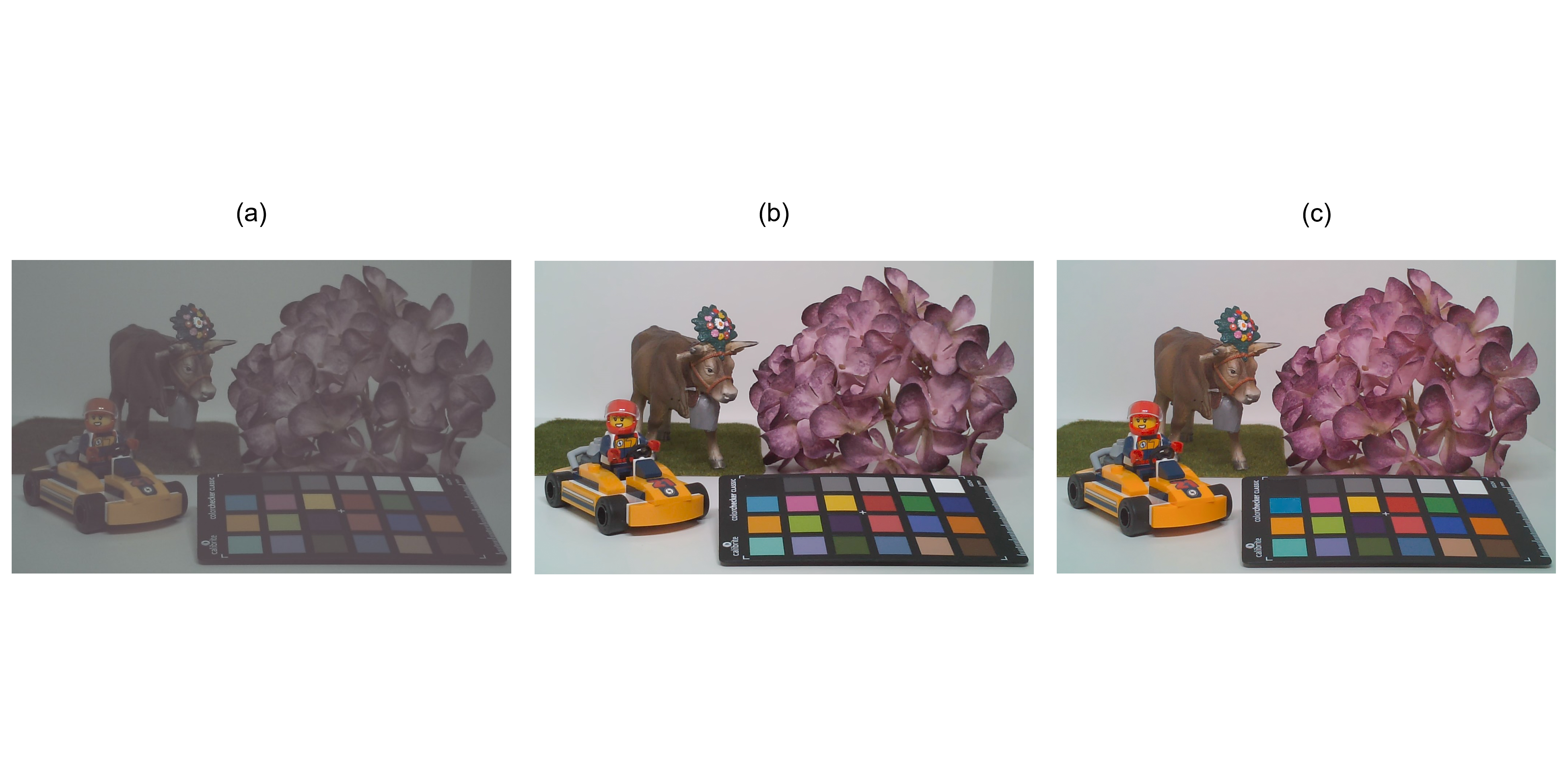
Outcome: How close does the low-cost camera come to the iPhone?
The modulation transfer of a camera is mainly restricted by the number of pixels and the optical quality of the lens. It can only be improved to a limited extent afterward using an edge enhancement filter. At this point, a low-cost camera like the Raspberry Pi V2 camera reaches its limits versus the iPhone 15 Pro.
In terms of color reproduction, the test measurements show that the low-cost camera is significantly closer to the actual values of the test chart than the iPhone images. The reason for this is that, while Helbling optimized the ISP for the Raspberry Pi V2 camera as closely as possible to the color chart used, smartphone manufacturers prefer images with defined color deviations, especially in the red and green tones, where colors are deliberately intensified to appear more vibrant.
This approach has already found its way into initial products in Helbling’s daily work: the principle of targeted ISP tuning for low-cost cameras is being applied in various current customer projects to achieve iPhone-like color reproduction. In addition to expertise in ISP tuning, the key is knowing where and to what extent color values should deliberately deviate from the original.
Summary: The image quality of affordable camera modules can approach that of the iPhone
The analyses and evaluations for this article show that when it comes to image quality, the entire system matters: Relevant factors for image quality include the optics, image sensor, camera drivers, and algorithms for image enhancement. In the digital world in particular, the potential of algorithms should not be underestimated.
In terms of modulation transfer, the iPhone holds an advantage. However, there are possibilities for approximation in color reproduction by adopting the typical color deviations of red and green tones found in iPhones. In addition to ISP tuning expertise, it is vital to know where and how much the color values need to be intentionally changed from the original. This approach has already found its way into Helbling's everyday work in the form of first products: the principle of targeted adjustment of the image signal processor in low-cost cameras is being implemented in several current customer projects to achieve iPhone-like color reproduction.
Authors: Sophie Jenne, Christoph Supper, Johannes Eckstein
Main Image: Helbling
References
[1] International Organization for Standardization, ISO 12233:2024 - Photography – Electronic imaging – Resolution and spatial frequency responses, ISO, 2024.
[2] Image Engineering
[3] Bildquelle: Coraye Wiki, "The Delta E," Coraye: The Prerequisites, [Online]. Available: https://wiki.coraye.com/books/coraye-the-prerequisites-en/page/the-delta-e. [Accessed: Feb. 18, 2025].
[4] H. H. Nasse, "How to read MTF curves," Carl Zeiss, Camera Lens Division, 2008.
[5] International Organization for Standardization, ISO 15739:2023 - Photography – Electronic imaging – Color measurement and quality control, ISO, 2023.
[6] Image Engineering, "OECF," IQ-AnalyzerX: Product Manual, [Online]. Available: https://wiki.image-engineering.de/doku.php?id=en:iq-analyzerx:product_manual#oecf. [Accessed: Feb. 18, 2025].
[7] International Organization for Standardization, ISO 17321:2012 - Photography – Electronic imaging – Image quality metrics, ISO, 2012.
[8] Image Engineering, "Color," IQ-AnalyzerX: Product Manual, [Online]. Available: https://wiki.image-engineering.de/doku.php?id=en:iq-analyzerx:product_manual. [Accessed: Feb. 18, 2025].
